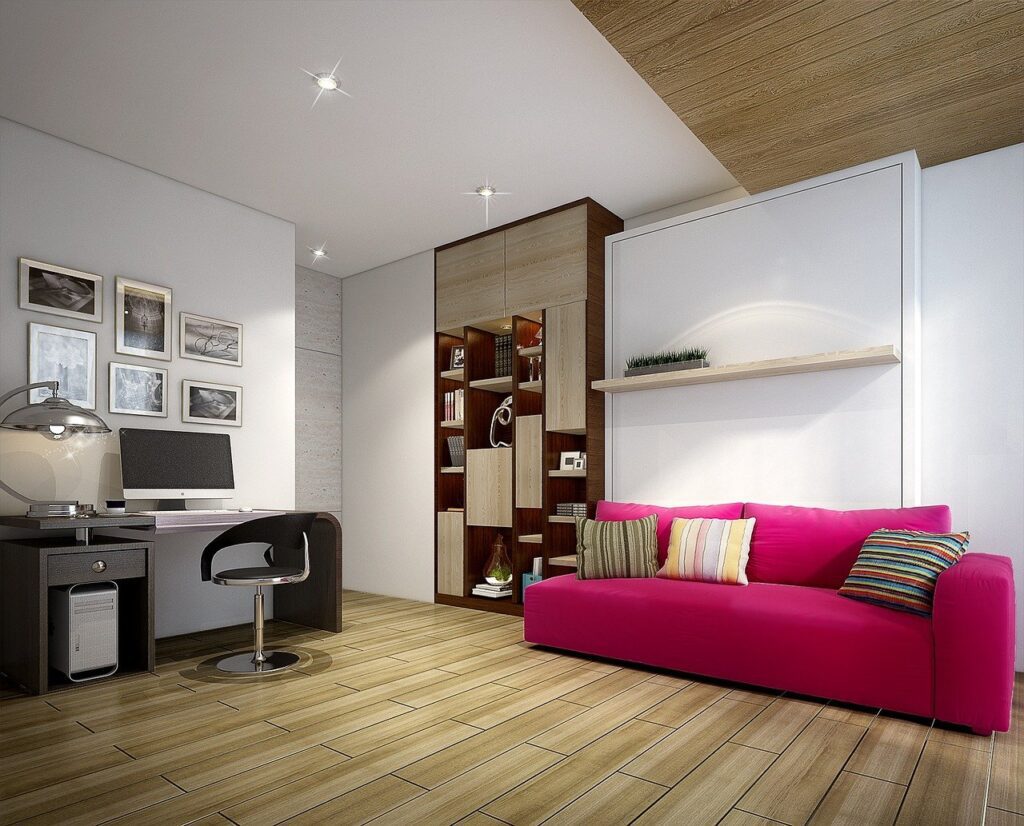Integrating smart home technology into your floor plan can transform your living space. By blending cutting-edge devices seamlessly with your home’s design, you create a modern and convenient living environment. Imagine controlling lighting, temperature, and security systems from the palm of your hand. Picture effortlessly streamlining your daily routines with voice commands or automated schedules. Embracing smart home tech not only enhances comfort but also boosts energy efficiency and adds value to your property. Discover how to merge functionality with aesthetics for a truly futuristic home experience.
Understanding Smart Home Technology
Definition
Smart home technology refers to a range of devices and systems that enhance home automation. These technologies are designed to make homes more efficient, convenient, and secure.
Smart home devices include smart thermostats, smart lighting systems, smart security cameras, and smart speakers like Amazon Echo or Google Home. These devices can be controlled remotely through a smartphone or a voice assistant.
Evolution
The evolution of smart home technology dates back to the late 20th century when the concept of home automation started gaining traction. However, it wasn’t until the early 2000s that advancements in technology led to the development of more sophisticated smart home devices.
In recent years, there has been a rapid proliferation of smart home technology due to advancements in wireless connectivity and Internet of Things (IoT). This has made it easier for homeowners to integrate various smart devices into their living spaces.
Significance
The growing significance of smart home technology lies in its ability to improve energy efficiency, enhance security, and increase convenience for homeowners. With smart thermostats, for example, homeowners can regulate their home’s temperature remotely, leading to energy savings.
Moreover, smart security cameras provide homeowners with real-time monitoring of their property, enhancing overall security. The integration of these devices into a floor plan can significantly enhance the quality of life for residents.
Connectivity and IoT
Connectivity plays a crucial role in enabling smart home functionalities. Through wireless networks and the Internet, smart devices can communicate with each other and with the homeowner. This interconnectedness allows for seamless control and monitoring of various aspects of the home.
The Internet of Things (IoT) further amplifies the capabilities of smart home technology by enabling devices to collect and exchange data. This data can then be used to automate tasks, optimize energy usage, and improve overall functionality within the home environment.
Benefits of Smart Home Integration
Convenience
Managing multiple devices from a single interface is one of the key conveniences of integrating smart home technology. With just a few taps on your smartphone or voice commands, you can control various aspects of your home, such as lighting, temperature, security cameras, and entertainment systems. This streamlined approach enhances user experience by providing a centralized hub for all your smart devices.
Energy
Smart home integration plays a significant role in enhancing energy efficiency, leading to cost savings through reduced utility bills. By automating the control of lights, thermostats, and appliances based on occupancy or schedules, you can optimize energy usage in your home. For instance, smart thermostats can adjust temperatures when you’re away, reducing unnecessary energy consumption. This proactive approach to managing energy usage not only benefits the environment but also helps you save money in the long run.
Planning Your Floor Plan Layout
Assessing Existing Layout
When assessing your existing floor plan, focus on identifying optimal locations for smart devices. Consider the placement of rooms, hallways, and outdoor spaces for seamless integration.
Designing for Daily Activities
When designing your floor plan, prioritize the flow of daily activities to ensure effective device placement. Think about how you move through your home daily and where smart devices can enhance convenience.
Utilizing Digital Tools
Utilize digital tools or software to visualize and modify your floor plan before implementation. These tools allow you to experiment with different layouts and placements for smart technology.
Choosing the Right Smart Devices
Researching Devices
When integrating smart home technology into your floor plan, start by researching various devices available on the market. Look for devices that align with your lifestyle and specific needs. Consider factors like security, energy efficiency, and convenience when selecting smart devices.
Explore different options such as smart thermostats, lighting systems, security cameras, and smart appliances. Each device serves a unique purpose and can enhance the functionality of your home. Compare features, reviews, and prices to make informed decisions about which devices will best suit your requirements.
Evaluating Compatibility
Ensure seamless integration by evaluating the compatibility of devices with your existing home systems. Check if the smart devices you choose can communicate effectively with each other and with your home’s network. Compatibility issues can hinder the performance of your smart home setup, so it’s essential to verify interoperability before making a purchase.
Consider factors such as connectivity protocols, hub requirements, and software compatibility when assessing the suitability of devices for integration. Opt for devices that can easily connect to your Wi-Fi network or smart home hub to create a cohesive ecosystem within your home.
Prioritizing Scalability
When selecting devices for your smart home setup, prioritize scalability to accommodate future upgrades and additions. Choose devices that offer flexibility and room for expansion as your needs evolve over time. Scalable devices allow you to build upon your existing smart home infrastructure without having to replace entire systems.
Invest in devices that are compatible with popular smart home platforms like Amazon Alexa or Google Home to ensure interoperability with a wide range of products. This compatibility enhances the scalability of your smart home setup by enabling you to add new devices from different manufacturers seamlessly.
Integrating Smart Lighting Solutions
Selecting Options
When considering integration of smart lighting solutions, opt for devices that offer remote control and automation. This allows you to adjust lighting settings conveniently.
Planning Zones
To effectively integrate smart lighting into your floor plan, plan for vision by creating different lighting zones. This enhances the ambiance and functionality of each space in your home.
Energy-efficient Bulbs
Incorporate energy-efficient smart bulbs to optimize powered blinds. These bulbs can adapt to your schedule and preferences, promoting a sustainable and cost-effective lighting solution.

Enhancing Home Security
Smart Locks
Implement smart locks in your home to enhance security. These locks provide real-time monitoring and alerts, offering a higher level of protection against potential intruders. By integrating smart locks, you can remotely control access to your home, ensuring that only authorized individuals can enter.
Comprehensive Security System
Create a comprehensive security system that covers your entire home. This system should include not only smart locks but also cameras, motion sensors, and alarms. By integrating these components, you can establish a robust security network that offers home coverage from various angles. Ensure that your security system is compatible with other smart devices in your house for seamless operation.
Family Education
Educate your family members on the effective use of security features. Ensure that everyone in your household understands how to operate the security system efficiently. By providing proper training and guidelines, you can maximize the effectiveness of your security systems and enhance the safety of your home.
Boosting Energy Efficiency
Replacing Appliances
Upgrade energy-consuming appliances with smart alternatives to optimize usage and minimize wastage. Smart appliances, such as refrigerators, washing machines, and thermostats, can be controlled remotely via mobile apps.
Switching to smart appliances not only enhances convenience but also contributes significantly to reducing overall energy consumption. These devices are designed to operate more efficiently, saving both energy and money in the long run.
Setting up Automation
Implement automation schedules for heating, cooling, and lighting systems to ensure optimal energy usage throughout the day. By programming these systems to adjust based on occupancy and time of day, you can minimize unnecessary energy consumption.
Automated systems can adapt to your daily routine, turning off when not needed and adjusting settings based on your preferences. This level of control allows for maximum efficiency without sacrificing comfort.
Monitoring Energy Consumption
Utilize smart meters to monitor your energy consumption in real-time and track your savings over time. These devices provide detailed insights into how much energy different appliances are using, helping you identify areas where further optimization is possible.
Centralized Control Systems
Choose Hub or App
Select a centralized hub or app that integrates all smart devices for seamless control from one location. This centralization enhances convenience and accessibility, streamlining the operation of various devices throughout your home.
Voice Command Integration
Integrate a control system that supports voice commands, enabling hands-free operation of your smart home technology. By utilizing voice commands, you can easily manage different areas of your home without the need to physically interact with individual devices.
Regular Updates
Ensure to regularly update the software and firmware of your centralized control system to maintain optimal security and functionality. Keeping your system up-to-date is crucial for safeguarding against potential vulnerabilities and ensuring smooth operation of your smart home automation.
Future-Proofing Your Smart Home
Stay Informed
To ensure your smart home remains up-to-date, stay informed about the latest technologies and trends. Regularly research new smart home products to understand their features and compatibility.
Invest in devices that work seamlessly with various platforms, such as Amazon Alexa, Google Assistant, or Apple HomeKit. This compatibility ensures that your home can adapt to changes in the smart home market without becoming obsolete.
Budget Planning
When planning your smart home integration, allocate a portion of your budget for future expansions. Leave room for additional devices and upgrades to accommodate advancements in smart home technology.
Consider creating a priority list of devices you want to integrate based on their importance and functionality. This approach helps you allocate funds efficiently and ensures a gradual transition to a fully integrated smart home.
Final Remarks
Incorporating smart home technology into your floor plan can revolutionize the way you interact with your living space. From enhancing convenience and security to optimizing energy usage, each aspect of smart home integration contributes to a more efficient and comfortable lifestyle. By carefully planning your layout, selecting the right devices, and future-proofing your home, you are setting the stage for a connected and intelligent living environment that adapts to your needs seamlessly.
Take the first step today by exploring the possibilities of integrating smart home technology into your floor plan. Embrace the future of home living by harnessing the power of automation, control, and efficiency at your fingertips. Your journey towards a smarter home starts now!
Design Your Perfect Floor Plan with Red White & Blue Construction!
Thinking about redesigning your floor plan? Your search ends here! Embark on an exciting journey to transform your Lafayette, CA home into the living space you’ve always dreamed of. With Red White & Blue Construction, every inch of your floor plan becomes a harmonious blend of beauty and functionality. Imagine innovative layouts that maximize your space’s potential, creating a natural flow that enhances both comfort and style. Whether you’re looking to optimize your current floor plan or dreaming up something entirely new, we’re here to bring your vision to life.
Our stellar reputation across the Bay Area speaks to our unwavering commitment to excellence, precision, and the highest standards of craftsmanship. We’re not just licensed contractors; we’re the creative minds behind your ideal living space. With transparent pricing and a client-first approach, you’re not just planning a floor—you’re laying the foundation for a whole new lifestyle. Choose Red White & Blue Construction and turn your home into a masterpiece. Design Your Perfect Floor Plan and connect with us today!
Disclaimer
The materials available on this website are for informational and entertainment purposes only and not to provide advice. You should obtain advice concerning any particular issue or problem from a professional. You should not act or refrain from acting based on any content included in this site without seeking legal or other professional advice. The information presented on this website may not reflect the most current building developments. No action should be taken in reliance on the information on this website. We disclaim all liability concerning actions taken or not taken based on any or all of the contents of this site to the fullest extent permitted by law.





